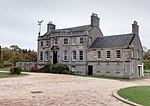Deaconsbank
Areas of GlasgowUse British English from May 2015

Deaconsbank is a neighbourhood in the Scottish city of Glasgow. It is situated south of the River Clyde. The main feature of the area, which falls into the Greater Pollok ward of Glasgow City Council and directly borders the East Renfrewshire council region, is an estate of around 639 private houses built in the late 1970s by Barratt Developments, prior to which the area was open farmland. Deaconsbank is bordered by the M77 motorway to the west and by Rouken Glen Park and golf course to the east. The northern parts of the suburban town of Newton Mearns are a short distance to the south, as is Patterton railway station.
Excerpt from the Wikipedia article Deaconsbank (License: CC BY-SA 3.0, Authors, Images).Deaconsbank
Deaconsbank Place, Glasgow Deaconsbank
Geographical coordinates (GPS) Address Nearby Places Show on map
Geographical coordinates (GPS)
| Latitude | Longitude |
|---|---|
| N 55.7973 ° | E -4.3304 ° |
Address
Deaconsbank Place
Deaconsbank Place
G46 7US Glasgow, Deaconsbank
Scotland, United Kingdom
Open on Google Maps







